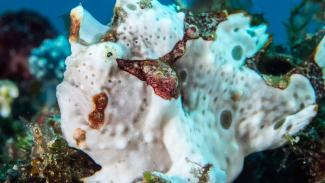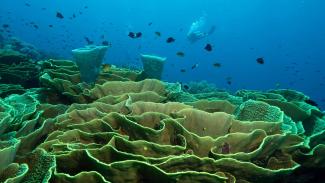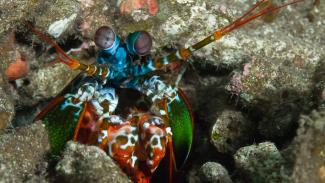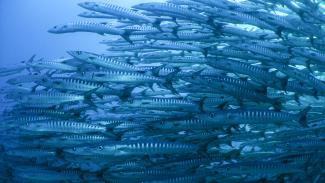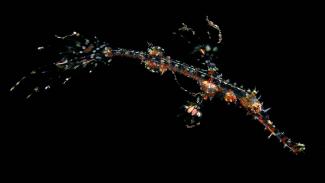Discover the birthplace of diving in the Philippines
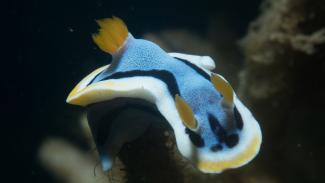
Diving in Anilao is a popular activity in part due to its proximity to Manila. However, little Anilao is a match for many top diving areas in the Philippines.
While there are colourful reefs to enjoy, diving in Anilao is especially known for smaller marine life, most notably nudibranchs. It is also very popular for underwater photography.
Considered to be the birthplace of scuba-diving in the Philippines. the area is finally gaining international recognition.
Highlights
Best diving spots
Many of the best dive sites are on Maricaban Island to the south and the smaller, adjacent islands of Caban & Sombrero.
Sombrero Island, so named due to its striking resemblance to a hat, has a shallow wall down to 30m that is home to Turtles, Rays, Trevally, Snapper and many other species. There have also been sightings of Blue-ringed Octopus here. Currents can be quite strong due to its exposed location.
Just off the tip of Caban Island are a few excellent dive sites such as Bajoura, Kirby’s Reef & Layanglang - all have normally good visibility and plentiful marine life, but often strong currents.
On the western-most tip of Maricaban Island is Sepok Point, a drop-off with plenty of smaller life that makes a nice dive. Nearby, Mapating Rock receives strong current and is only suitable for experienced divers. The submerged rock receives plenty of pelagic action though and has a cave where Whitetip Reef Sharks sleep. Further to the east is another shallow, submerged rock called Devil’s Point.
To the east of Maricaban Island is one of the area’s more unusual dives. The almost unpronounceable Malajibomanoc has an underwater hot-spring at around 20m that produces an almost constant stream of bubbles rising to the surface. Whenever the nearby Taal volcano has an upsurge in activity, the hot springs here produce more bubbles. Frogfish can often be seen near here and Blacktip Reef Sharks sometimes cruise by.
Closer to Anilao is Cathedral Rock. Back in the early days of Scuba-diving here, coral was transplanted onto a barren rock formation, against the wisdom of prominent scientists at the time. Suprisingly, the corals took hold and are now an excellent dive site, with colourful hard & soft corals and plenty of marine life. This site is home to another of the area’s diving oddities - an underwater shrine that has been blessed...... by the Pope, no less. As the Pope at the time was not acquainted with diving, it was blessed on land and then put underwater by General Fidel the fifth, who later became President of the Philippines.
On the east side of Batangas Bay is Verde Island, a very popular spot for a day trip from Anilao or Puerto Galera. There are nice fringing reefs all round the island, but the most popular site is a superb wall dive. Huge corals of every hue & colour cling to the wall and reef-life is prolific. There is a great chance to encounter larger fish here as well. Napoleon Wrasse often cruise the wall, while Tuna & Reef Sharks patrol the blue. Eagle Rays and Mantas can be seen too.
When to dive
The weather here falls in two main seasons, the dry season, from November to May and the wet season, from June to October. The best time to dive in Anilao is between February and May.
Getting there
Anilao is quite easy to reach. From Manila, which has an international airport, take a bus, resort transfer or taxi straight to Anilao in the south. The journey is around two and a half hours. Batangas Bay is also connected by ferry to Puerto Galera, as well as many other parts of the Philippines.
Activities
Aside from the diving, trips around the island and other water activities are popular. Visiting the nearby mountains is also a good day out.
Resort and liveaboard options
There are numerous dive resorts in Anilao to choose from catering for a wide range of budgets, the majority of which will also arrange transfers from Manila for convenience.
You might also enjoy...
Maumere
Maumere is a beautiful bay on the north coast of Flores. It is an area that is famous for its diversity.
Sperm Whales, Pilot Whales, Dolphins & Whalesharks cruise the bay, good encounters with Sharks & large Rays are possible and there is a wealth of macro life to keep any diver fascinated for hours.
Kimbe Bay
Kimbe Bay is on the island of New Britain, a large island running east to west that separates the Solomon Sea to the south from the Bismark Sea to the north.
The area is known for its stunning coral formations and boasts a huge diversity of marine life, from Dolphins, Sharks and Whales to endless tiny invertebrates.
Milne Bay
Milne Bay can be found at the south-eastern tip of mainland Papua New Guinea, separating the Soloman Sea from the Coral Sea to the south.
It is a beautiful & charming place, with lush mountains, lovely beaches, picturesque villages and friendly people.
Sipadan & Mabul Island
Sipadan is Malaysia’s most famous diving spot. Nearby, Mabul Island offers more excellent diving for smaller marine life, and a good choice of dive resorts.
These nutrient-rich waters attract huge numbers of Turtles, while the area is also home to large number of White-tip Reef Sharks, Bumphead Parrotfish, Trevally and Barracuda.
Underwater housing care
Jakob Owens


